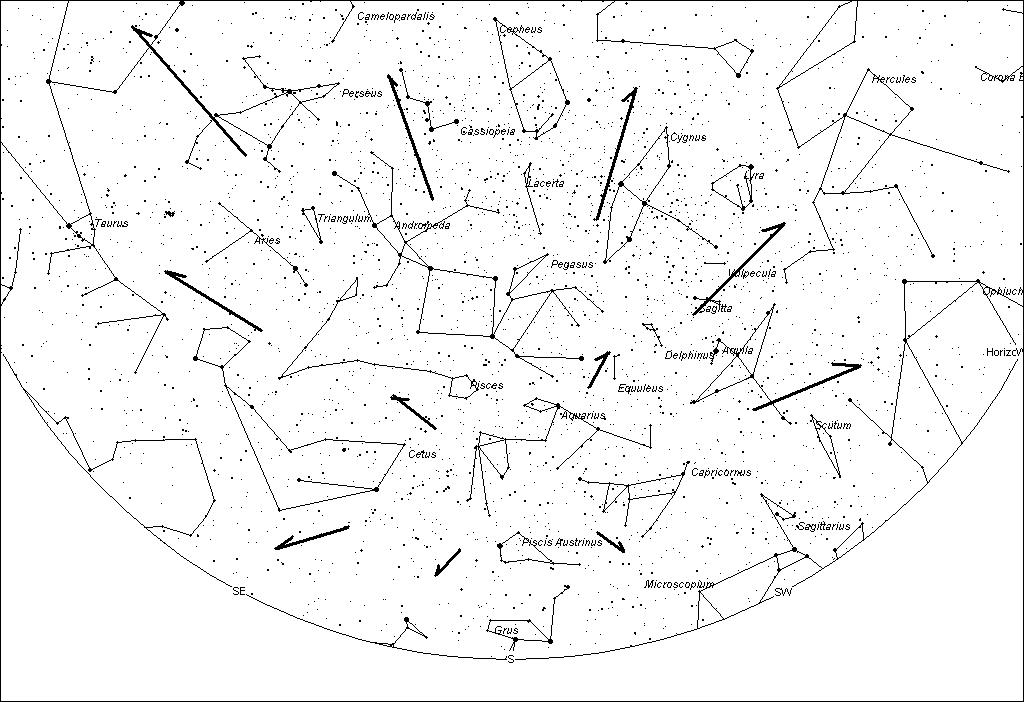The Southern delta-Aquariids (SDA) are active from July 21 through August 23 with maximum activity occurring on July 30. This shower possesses a very asymmetric activity profile in that it quickly reaches maximum activity and then slowly dissipates throughout August. When the shower becomes active, the radiant lies in southwestern Aquarius, not far from the Capricornus border. The nearest bright star is 3rd magnitude Deneb Algedi (delta Capricornii) which lies 6 degrees to the northwest. The radiant travels nearly a degree eastward each night and at maximum activity on the 30th it lies in central Aquarius, 4 degrees west of the 3rd magnitude star known as Skat (delta Aquarii). After maximum the radiant traverses eastern Aquarius and enters southwestern Pisces before the activity totally dissipates.

Unlike the Perseids of August, the Southern delta-Aquariids possess a flat maximum were rates will be good for several nights surrounding maximum. The quoted zenith hourly rate for this shower is 25, but observations from equatorial locations where the radiant lies high in the sky has produced rates in excess of 30. Realistic maximum rates from dark sky sites at latitude 30°N would be 20 meteor per hour and 10 at 50°N.
As seen from mid-northern latitudes, the radiant rises near 22:00 (10pm) local daylight saving time. Little activity is seen at this time and it is better to wait at least until midnight when the radiant has gained more altitude. The radiant lies highest in the sky near 03:00 and this is the best time to try and view activity from this source.
This year the moonlight situation is favorable for the Southern delta-Aquariids as the moon is at its first quarter phase on July 30th. For viewers in mid-northern latitudes the half-illuminated moon will set near 01:00, leaving the remainder of the morning free of interfering moonlight. While viewing this activity you will notice other meteors that are not members of this shower. Most active will be the swift Perseids, which will usually have a north to south trajectory. The other notable shower is the slow alpha-Capricornids, which will shoot from a radiant in northwestern Capricornus. Of course there will also be random activity shooting in all directions having variable velocities. To best see the Southern delta-Aquariids I would suggest facing due south approximately half-way up in the sky. Most of the SDA activity will shoot upward into your field of view. Most of these meteors are on the faint side and easily missed. It helps to find a dark location away from street lights to increase your chances of viewing more activity. Take advantage of the favorable schedule this year as next year the SDA’s will be spoiled by a bright Moon.



 You saw something bright and fast? Like a huge shooting star? Report it: it may be a fireball.
You saw something bright and fast? Like a huge shooting star? Report it: it may be a fireball.  You counted meteors last night? Share your results with us!
You counted meteors last night? Share your results with us!  You took a photo of a meteor or fireball? You have a screenshot of your cam? Share it with us!
You took a photo of a meteor or fireball? You have a screenshot of your cam? Share it with us!  You caught a meteor or fireball on video? Share your video with us!
You caught a meteor or fireball on video? Share your video with us!